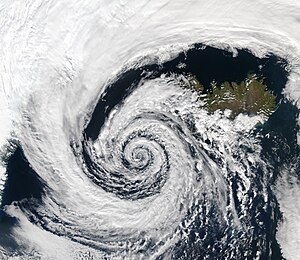 Global Information
Global InformationCyclone information

| Part of a series on |
| Weather |
|---|
|
|
In meteorology, a cyclone (/ˈsaɪ.kloʊn/) is a large air mass that rotates around a strong center of low atmospheric pressure, counterclockwise in the Northern Hemisphere and clockwise in the Southern Hemisphere as viewed from above (opposite to an anticyclone).[1][2] Cyclones are characterized by inward-spiraling winds that rotate about a zone of low pressure.[3][4] The largest low-pressure systems are polar vortices and extratropical cyclones of the largest scale (the synoptic scale). Warm-core cyclones such as tropical cyclones and subtropical cyclones also lie within the synoptic scale.[5] Mesocyclones, tornadoes, and dust devils lie within the smaller mesoscale.[6]
Upper level cyclones can exist without the presence of a surface low, and can pinch off from the base of the tropical upper tropospheric trough during the summer months in the Northern Hemisphere. Cyclones have also been seen on extraterrestrial planets, such as Mars, Jupiter, and Neptune.[7][8] Cyclogenesis is the process of cyclone formation and intensification.[9] Extratropical cyclones begin as waves in large regions of enhanced mid-latitude temperature contrasts called baroclinic zones. These zones contract and form weather fronts as the cyclonic circulation closes and intensifies. Later in their life cycle, extratropical cyclones occlude as cold air masses undercut the warmer air and become cold core systems. A cyclone's track is guided over the course of its 2 to 6 day life cycle by the steering flow of the subtropical jet stream.
Weather fronts mark the boundary between two masses of air of different temperature, humidity, and densities, and are associated with the most prominent meteorological phenomena. Strong cold fronts typically feature narrow bands of thunderstorms and severe weather, and may on occasion be preceded by squall lines or dry lines. Such fronts form west of the circulation center and generally move from west to east; warm fronts form east of the cyclone center and are usually preceded by stratiform precipitation and fog. Warm fronts move poleward ahead of the cyclone path. Occluded fronts form late in the cyclone life cycle near the center of the cyclone and often wrap around the storm center.
Tropical cyclogenesis describes the process of development of tropical cyclones. Tropical cyclones form due to latent heat driven by significant thunderstorm activity, and are warm core.[10][11] Cyclones can transition between extratropical, subtropical, and tropical phases.[12] Mesocyclones form as warm core cyclones over land, and can lead to tornado formation.[13] Waterspouts can also form from mesocyclones, but more often develop from environments of high instability and low vertical wind shear.[14] In the Atlantic and the northeastern Pacific oceans, a tropical cyclone is generally referred to as a hurricane (from the name of the ancient Central American deity of wind, Huracan), in the Indian and south Pacific oceans it is called a cyclone, and in the northwestern Pacific it is called a typhoon.[15] The growth of instability in the vortices is not universal. For example, the size, intensity, moist-convection, surface evaporation, the value of potential temperature at each potential height can affect the nonlinear evolution of a vortex.[16][17]
- ^ Glossary of Meteorology (June 2000). "Cyclonic circulation". American Meteorological Society. Archived from the original on 2018-12-25. Retrieved 2008-09-17.
- ^ Glossary of Meteorology (June 2000). "Cyclone". American Meteorological Society. Archived from the original on 2018-12-25. Retrieved 2008-09-17.
- ^ BBC Weather Glossary (July 2006). "Cyclone". BBC. Archived from the original on 2006-08-29. Retrieved 2006-10-24.
- ^ "UCAR Glossary — Cyclone". University Corporation for Atmospheric Research. Archived from the original on 2018-12-25. Retrieved 2006-10-24.
- ^ National Hurricane Center (2012). Glossary of NHC terms. Archived 2012-09-27 at the Wayback Machine Retrieved on 2012-08-13.
- ^ I. Orlanski (1975). "A rational subdivision of scales for atmospheric processes". Bulletin of the American Meteorological Society. 56 (5): 527–530. Bibcode:1975BAMS...56..527.. doi:10.1175/1520-0477-56.5.527.
- ^ Cite error: The named reference
Brandwas invoked but never defined (see the help page). - ^ Samantha Harvey (2006-10-02). "Historic Hurricanes". NASA. Archived from the original on 2008-04-15. Retrieved 2008-06-14.
- ^ Nina A. Zaitseva (2006). "Cyclogenesis". National Snow and Ice Data Center. Archived from the original on 2006-08-30. Retrieved 2006-12-04.
- ^ "Tropical cyclogenesis". www-das.uwyo.edu. Archived from the original on 17 May 2021. Retrieved 12 January 2021.
- ^ Stan Goldenberg (2004-08-13). "Frequently Asked Questions: What is an extra-tropical cyclone?". Atlantic Oceanographic and Meteorological Laboratory, Hurricane Research Division. Archived from the original on 2007-02-09. Retrieved 2007-03-23.
- ^ Evans, Clark; Wood, Kimberly M.; Aberson, Sim D.; Archambault, Heather M.; Milrad, Shawn M.; Bosart, Lance F.; Corbosiero, Kristen L.; Davis, Christopher A.; Pinto, João R. Dias; Doyle, James; Fogarty, Chris; Galarneau, Thomas J.; Grams, Christian M.; Griffin, Kyle S.; Gyakum, John; Hart, Robert E.; Kitabatake, Naoko; Lentink, Hilke S.; McTaggart-Cowan, Ron; Perrie, William; Quinting, Julian F. D.; Reynolds, Carolyn A.; Riemer, Michael; Ritchie, Elizabeth A.; Sun, Yujuan; Zhang, Fuqing (1 November 2017). "The Extratropical Transition of Tropical Cyclones. Part I: Cyclone Evolution and Direct Impacts" (PDF). Monthly Weather Review. 145 (11): 4317–4344. Bibcode:2017MWRv..145.4317E. doi:10.1175/MWR-D-17-0027.1. ISSN 1520-0493. S2CID 38114516. Retrieved 12 January 2021.
- ^ Cite error: The named reference
FoNwas invoked but never defined (see the help page). - ^ Cite error: The named reference
NWSwas invoked but never defined (see the help page). - ^ "Frequently asked questions". Hurricane Research Division. Archived from the original on 2011-03-09. Retrieved 2006-04-08.
- ^ Rostami, Masoud; Zeitlin, Vladimir (2017). "Influence of condensation and latent heat release upon barotropic and baroclinic instabilities of vortices in a rotating shallow water f-plane model" (PDF). Geophysical & Astrophysical Fluid Dynamics. 111 (1): 1–31. Bibcode:2017GApFD.111....1R. doi:10.1080/03091929.2016.1269897. S2CID 55112620. Archived (PDF) from the original on 2020-02-26. Retrieved 2019-12-07.
- ^ Rostami, Masoud; Zeitlin, Vladimir (2018). "An improved moist-convective rotating shallow-water model and its application to instabilities of hurricane-like vortices" (PDF). Quarterly Journal of the Royal Meteorological Society. 144 (714): 1450. Bibcode:2018QJRMS.144.1450R. doi:10.1002/qj.3292. S2CID 59493137. Archived (PDF) from the original on 2020-03-05. Retrieved 2019-12-07.